Development and Research of New Hybrid Composites in Order to Increase Reliability and Durability of Structural Elements
Abstract
1. Introduction
Research Objectives
- -
- Substantiation of the choice of materials for hybrid composites (Section 2);
- -
- Substantiation of the choice of equipment and technologies for the formation of hybrid composite materials (Section 2);
- -
- Assessment of the influence of high-energy mechanical processing of powder materials AlCoCrCuFeNi, cBNCoMo, and B4CCoMo on the quality and mechanical properties of composites (Section 2);
- -
- Development of statistical models for optimizing the technological parameters of the formation of composite materials (Section 3.1);
- -
- Study of the structure and structural parameters of composite materials after complex processing (Section 3.2);
- -
- Study of the mechanical properties and fatigue testing of the obtained composites (Section 3.3);
- -
- Testing of the developed composites for friction wear (Section 3.3);
- -
- Substantiation of the choice of high-temperature thermomechanical treatment in order to improve the mechanical properties of composites (Section 4.1);
- -
- Substantiation of the choice of the “architecture” of composite materials (Section 4.2).
2. Materials and Research Methods
2.1. Materials
2.2. High-Energy Machining
2.3. Formation of Layered Composites
2.4. Mechanical Test
3. Results
3.1. Design of Statistical Models for Hybrid Composites Using a Multifunctional Technological Complex
3.2. Structure and Structural Parameters of Composite Materials
3.3. Performance Properties of Surface-Modified Composite Materials
4. Discussion
4.1. High-Temperature Thermomechanical Treatment of Layered Composite Materials
4.2. Multifunctional Surface Compositions “AlCoCrCuFeNi—cBNCoMo” and “AlCoCrCuFeNi—B4CCoMo”
5. Conclusions
- We increased the adhesive strength of the composite layers from 68 to 192 MPa with the developed technology.
- We substantiated the choice of powder materials for the formation of high-entropy AlCoCrCuFeNi and ceramic cBNCoMo(B4CCoMo) layers of composites to increase the reliability and durability of the products.
- We improved the adhesive properties and quality (reduction of porosity) of composite layers using high-energy processing of AlCoCrCuFeNi, cBNCoMo, and B4CCoMo powder materials.
- We developed statistical models for optimizing the technological parameters for the formation of composite materials.
- We described the technological regimens of high-temperature thermomechanical treatment in order to improve the mechanical properties of composites (adhesion).
- We studied the structure of AlCoCrCuFeNi, cBNCoMo, and B4CCoMo composites after complex processing. The studies show that the AlCoCrCuFeNi layer has a grain size of 75–123 nm, the cBNCoMo layer has a grain size of 92–136 nm, and the B4CCoMo layer has a grain size of 86–163 nm. The microhardness was Hastelloy X (NiCrFeMo) HV = 3.8 ÷ 3.95 GPa; AlCoCrCuFeNi HV = 4.41 ÷ 4.57 GPa; cBNCoMo, HV = 34.3 ÷ 34.8 GPa; and B4CCoMo, HV = 18.7 ÷ 18.9 GPa.
- We performed mechanical tests of hybrid composites Hastelloy X (NiCrFeMo)—AlCoCrCuFeNi—cBNCoMo and Hastelloy X (NiCrFeMo)—AlCoCrCuFeNi—B4CCoMo for cyclic durability (fatigue mechanical tests) and friction wear. The tests show that the endurance limit of Hastelloy X (NiCrFeMo) alloy samples was 340 MPa, with AlCoCrCuFeNi—cBNCoMo composite surface layers of 410 Mpa and AlCoCrCuFeNi—B4CCoMo composite surface layers of 385 MPa. The use of surface-layered materials AlCoCrCuFeNi—cBNCoMo and AlCoCrCuFeNi—B4CCoMo in the composition of hybrid composites increases cyclic durability.
Author Contributions
Funding
Data Availability Statement
Acknowledgments
Conflicts of Interest
References
- Sagalovych, A.; Sagalovych, V.; Popov, V.; Dudnik, S. Vacuum-Plasma Multilayer Protective Coatings for Turbine Blades; Scientific Route OÜ: Tallinn, Estonia, 2021; 104p. [Google Scholar] [CrossRef]
- Blednova, Z.M.; Rusinov, P.O. Promising Materials and Technologies: Formation of Multifunctional Surface Compositions from High-Entropy Alloys with Thermoelastic Martensitic Transformations; Rubanik, V.V., Ed.; BSU Publishing Center: Minsk, Belarus, 2021; 658p. [Google Scholar]
- Duchaniya, R.K.; Pandel, U.; Rao, P. Coatings based on high entropy alloys: An overview. Mater. Today Proc. 2021, 44, 4467–4473. [Google Scholar] [CrossRef]
- Lin, C.; Yao, Y. Corrosion-Resistant Coating Based on High-Entropy Alloys. Metals 2023, 13, 205. [Google Scholar] [CrossRef]
- Fu, M.; Ma, X.; Zhao, K.; Li, X.; Su, D. High-entropy materials for energy-related applications. iScience 2021, 24, 102177. [Google Scholar] [CrossRef] [PubMed]
- Ma, Y.; Ma, Y.; Wang, Q.; Schweidler, S.; Botros, M.; Fu, T.; Hahn, H.; Brezesinski, T.; Breitung, B. High-entropy energy materials: Challenges and new opportunities. Energy Environ. Sci. 2021, 14, 2883. [Google Scholar] [CrossRef]
- Mehmood, M.A.; Shehzad, K.; Mujahid, M.; Yaqub, T.B.; Godfrey, A.; Fernandes, F.; Muhammad, F.Z.; Yaqoob, K. Ceramic-reinforced HEA matrix composites exhibiting an excellent combination of mechanical properties. Sci. Rep. 2022, 12, 21486. [Google Scholar] [CrossRef] [PubMed]
- Medina, L.Z.; Riekehr, L.; Jansson, U. Phase formation in magnetron sputtered CrMnFeCoNi high entropy alloy. Surf. Coat. Technol. 2020, 403, 126323. [Google Scholar] [CrossRef]
- Moghaddam, A.O.; Shaburova, N.A.; Samodurova, M.N.; Abdollahzadeh, A.; Trofimov, E.A. Additive manufacturing of high entropy alloys: A practical review. J. Mater. Sci. Technol. 2021, 77, 131–162. [Google Scholar] [CrossRef]
- Ananiadis, E.; Argyris, K.T.; Matikas, T.E.; Sfikas, A.K.; Karantzalis, A.E. Microstructure and Corrosion Performance of Aluminium Matrix Composites Reinforced with Refractory High-Entropy Alloy Particulates. Appl. Sci. 2021, 11, 1300. [Google Scholar] [CrossRef]
- Akrami, S.; Edalati, P.; Fuji, M.; Edalati, K. High-entropy ceramics: Review of principles, production and applications. Mater. Sci. Eng. R Rep. 2021, 146, 100644. [Google Scholar] [CrossRef]
- Chang, Y.; Sun, X.; Ma, M.; Mu, C.; Li, P.; Li, L.; Li, M.; Nie, A.; Xiang, J.; Zhao, Z.; et al. Application of hard ceramic materials B4C in energy storage: Design B4C@C core-shell nanoparticles as electrodes for flexible all-solid-state micro-supercapacitors with ultrahigh cyclability. Nano Energy 2020, 75, 104947. [Google Scholar] [CrossRef]
- Kara, M.; Coskun, T.; Gunoz, A. Influence of B4C on enhancing mechanical properties of AA2014 aluminum matrix composites. Part C J. Mech. Eng. Sci. 2021, 236, 5. [Google Scholar] [CrossRef]
- Makhutov, N.A.; Matvienko, Y.G.; Blednova, Z.M.; Rusinov, P.O.; Dmitrenko, D.V. The effect of surface coating by shape memory alloys on mechanical properties of steel. Fatigue Fract. Eng. Mater. Struct. 2022, 45, 1550–1553. [Google Scholar] [CrossRef]
- Rusinov, P.O.; Blednova, Z.M.; Kurapov, G.V. Functionally-oriented composite layered materials with martensitic transformations. Surf. Innov. 2023, 11, 26–37. [Google Scholar] [CrossRef]
- Rusinov, P.O.; Blednova, Z.M. Physicomechanical and design characteristics of surface high-entropy alloys. Part L J. Mater. Des. Appl. 2021, 235, 1635–1644. [Google Scholar] [CrossRef]
- Yang, L.; Shi, X.; Tian, X.; Wang, H.; Qi, L. Microstructure and corrosion behavior of ZrO2 coated carbon fiber reinforced magnesium matrix composites sprayed with different powder characteristics. Ceram. Int. 2022, 48, 30797–30806. [Google Scholar] [CrossRef]
- Mostafa, H.; Sliem, O.F.; Shakoor, R.A.; Bagheridard, S.; Mansoor, B.; Abdullah, A.; Mohamed, A.; Mohamed, A. The influence of different preparation methods on the erosion behavior of NiP-ZrO2 nanocomposite coating. Tribol. Int. 2023, 178, 108014. [Google Scholar] [CrossRef]
- Kim, S.; Kim, T.; Hong, E.; Jo, I.; Kim, J.; Lee, H. Phase Formation and Wear Resistance of Carbon-Doped TiZrN Nanocomposite Coatings by Laser Carburization. Metals 2021, 11, 590. [Google Scholar] [CrossRef]
- Lee, D.; Kim, J.; Park, B.; Jo, I.; Lee, S.K.; Kim, Y.; Lee, S.B.; Cho, S. Mechanical and Thermal Neutron Absorbing Properties of B4C/Aluminum Alloy Composites Fabricated by Stir Casting and Hot Rolling Process. Metals 2021, 11, 413. [Google Scholar] [CrossRef]
- Blednova, Z.M.; Makhutov, N.A.; Rusinov, P.O.; Dmitrienko, D.V.; Balaev, E.Y. Analysis of the Efficiency of Functionally Oriented Composite Coatings Made of Materials with Thermoelastic Martensitic Transformations. Russ. Metall. 2021, 2021, 1224–1232. [Google Scholar] [CrossRef]
- Rusinov, P.O.; Blednova, Z.M. Study of the structure and properties of a high-entropy ceramic composite material. Surf. Innov. 2022, 10, 217–226. [Google Scholar] [CrossRef]
- Cai, X.; Zhang, N.; Liu, H. Thickness dependence of viscoelastic stress relaxation of laminated microbeams due to mismatch strain. Appl. Math. Mech. 2022, 43, 467–478. [Google Scholar] [CrossRef]
- Maleki, E.; Unal, O.; Guagliano, M.; Bagherifard, S. Analysing the Fatigue Behaviour and Residual Stress Relaxation of Gradient Nano-Structured 316L Steel Subjected to the Shot Peening via Deep Learning Approach. Met. Mater. Int. 2022, 28, 112. [Google Scholar] [CrossRef]
- Duan, Y.J.; Qiao, J.C.; Wada, T.; Kato, H.; Pineda, E.; Crespo, D.; Wang, Y.J. Stress relaxation in high-entropy Pd20Pt20Cu20Ni20P20 metallic glass: Experiments, modeling and theory. Mech. Mater. 2021, 160, 103959. [Google Scholar] [CrossRef]
- Lee, S.; Duarte, M.J.; Feuerbacher, M.; Soler, R.; Kirchlechner, C.; Liebscher, C.H.; Oh, S.H.; Dehm, G. Dislocation plasticity in FeCoCrMnNi high-entropy alloy: Quantitative insights from in situ transmission electron microscopy deformation. Mater. Res. Lett. 2020, 8, 6. [Google Scholar] [CrossRef]
- Rozman, K.A.; Detrois, M.; Liu, T.; Gao, M.C.; Jablonski, P.D.; Hawk, J.A. Long-Term Creep Behavior of a CoCrFeNiMn High-Entropy Alloy. J. Mater. Eng. Perform. 2020, 29, 5822–5839. [Google Scholar] [CrossRef]
- Campari, E.G.; Casagrande, A. Mechanical Spectroscopy Study of CrNiCoFeMn High-Entropy Alloys. Materials 2023, 16, 3689. [Google Scholar] [CrossRef]
- Belov, M.M.; Ivanov, I.A.; Uglov, V.V.; Zlotski, S.V.; Jin, K.; Stepanjuk, N.A.; Ryskulov, A.E.; Kozlovskiy, A.L.; Koloberdin, M.V.; Kurakhmedov, A.E.; et al. Stress evolution in NiCoFeCrMn and NiCoFeCr high-entropy alloys irradiated by helium and krypton ions. In Proceedings of the 8th International Congress on Energy Fluxes and Radiation Effects (EFRE–2022), Tomsk, Russia, 29–30 September 2022; pp. 1082–1087. [Google Scholar] [CrossRef]
- Duan, Y.J.; Zhang, L.T.; Qiao, J.C.; Wang, Y.J.; Yang, Y.; Wada, T.; Kato, H.; Pelletier, J.M.; Pineda, E.; Crespo, D. Intrinsic Correlation between the Fraction of Liquidlike Zones and the β Relaxation in High-Entropy Metallic Glasses. Phys. Rev. Lett. 2022, 129, 175501. [Google Scholar] [CrossRef]
- Liu, W.; Otegi, N.; Orallo, A.; Barrenetxea, M.; Aizpuru, I.; Lian, J.; Mendiguren, J. Post-forming, electro-plastic effect internal stress reduction in AA5754 aluminium alloy. Mater. Sci. Eng. A 2022, 852, 143686. [Google Scholar] [CrossRef]
- Lee, Y.S.; Sung, J.H. Microstructure and Mechanical Properties of Hastelloy X Fabricated Using Directed Energy Deposition. Metals 2023, 13, 885. [Google Scholar] [CrossRef]
- Liu, M.; Zeng, Q.; Hua, Y.; Zheng, W.; Wu, Y.; Jin, Y.; Li, Y.; Wang, J.; Zhang, K. High-Temperature Tensile Properties of Hastelloy X Produced by Laser Powder Bed Fusion with Different Heat Treatments. Metals 2022, 12, 1435. [Google Scholar] [CrossRef]
- Wang, H.; Wu, H.; Liu, Y.; Qiu, W.; Deng, H.; Zhou, L.; Chen, L. Oxidation Behavior of Hastelloy X Alloy Fabricated by Selective Laser Melting and Subsequent Hot Isostatic Pressing Treatment. Adv. Eng. Mater. 2022, 24, 2200369. [Google Scholar] [CrossRef]
- Baranowski, M.; Senkara, J. Mechanical Properties of Structural Components in Hastelloy X Joints Brazed with Ni-Pd-Cr-B-Si Alloy. Materials. 2023, 16, 1115. [Google Scholar] [CrossRef]
- Yin, W.; Ruidi, L.; Pengda, N.; Zhijian, Z.; Tiechui, Y.; Jiwei, Y.; Kun, L. Microstructures and properties of equimolar AlCoCrCuFeNi high-entropy alloy additively manufactured by selective laser melting. Intermetallics 2020, 120, 106746. [Google Scholar] [CrossRef]
- Prabu, G.; Duraiselvam, M.; Jeyaprakash, N.; Yang, C.-H. Microstructural Evolution and Wear Behavior of AlCoCrCuFeNi High Entropy Alloy on Ti–6Al–4V Through Laser Surface Alloying. Met. Mater. Int. 2021, 27, 2328–2340. [Google Scholar] [CrossRef]
- Bian, C.H.; Yang, W.J.; Zhang, W.; Li, Q.; Wen, J.; Feng, L. Analysis of the effect of FeCr phase and AlCo phase in the friction process of AlCoCrCuFeNi high entropy alloy coating. J. Lanzhou Univ. Technol. 2023, 49, 9–16. [Google Scholar]
- Kuznetsov, A.V.; Shaisultanov, D.G.; Stepanov, N.; Salishchev, G.A.; Senkov, O.N. Superplasticity of AlCoCrCuFeNi High Entropy Alloy. Mater. Sci. Forum 2012, 735, 146–151. [Google Scholar] [CrossRef]
- Plevachuk, Y.; Brillo, J.; Yakymovych, A. AlCoCrCuFeNi-Based High-Entropy Alloys: Correlation Between Molar Density and Enthalpy of Mixing in the Liquid State. Metall. Mater. Trans. A 2018, 49, 6544. [Google Scholar] [CrossRef]
- Veeresha, G.; Manjunatha, B.; Nagaral, M.; Auradi, V.; Bharath, V. Synthesis and wear behavior of varying particle sized B4C reinforced Al2618 alloy composites. Mater. Phys. Mech. 2022, 50, 373. [Google Scholar] [CrossRef]
- Velayatipour, O.; Nikzad, L.; Farvizi, M. B4C reinforced NiTi-based composites: Microstructure and wear performance. Appl. Ceram. Technol. 2023, 20, 1667–1680. [Google Scholar] [CrossRef]
- Bharathi, B.; Sampath, K.S. Mechanical Characteristics and Wear Behaviour of Al/SiC and Al/SiC/B4C Hybrid Metal Matrix Composites Fabricated Through Powder Metallurgy Route. Silicon 2023. online ahead of print. [Google Scholar] [CrossRef]
- Li, Q. Quantification of Internal Stress and Cracking in Ambient Temperature Curing Thermoset Coatings. Ph.D. Thesis, Technical University of Denmark, Lyngby, Denmark, 2022; 136p. [Google Scholar]
- Zhu, Y.; Zheng, B.; Hu, C.; Pei, H.; Song, P. Influence of Gradient Index and Pores on the Properties and Internal Stress of Continuous Transition Ceramic–Metal Coating. Coatings 2022, 12, 569. [Google Scholar] [CrossRef]
- Rae, W.; Rahimi, S. Effect of stress relaxation on the evolution of residual stress during heat treatment of Ti-6Al-4V. MATEC Web Conf. 2020, 321, 11001. [Google Scholar] [CrossRef]
- Lai, J.; Tran, D.; Yang, S.; Tseng, I.; Shie, K.; Leu, J.; Chen, C. Stress Relaxation and Grain Growth Behaviors of (111)-Preferred Nanotwinned Copper during Annealing. Nanomaterials 2023, 13, 709. [Google Scholar] [CrossRef]
- Batra, N.K.; Dikshit, I.; Singh, R.P. Experimental Investigations and Statistical Modeling of Specific Wear and Coefficient of Friction in a Novel Carbon Fiber-Reinforced Composite. Int. J. Surf. Eng. Interdiscip. Mater. Sci. 2022, 10, 1–17. [Google Scholar] [CrossRef]
- Juliá, J.M.; Rodríguez-Tembleque, L.; Ferri Aliabadi, M.H. Wear. In Advanced Engineering Applications and Materials: Wear Modelling in Fibre-Reinforced Composite Materials; World Scientific Publishing Europe Ltd.: Singapore, 2022; Chapter 8; pp. 205–236. [Google Scholar] [CrossRef]
- Basu, B.; Kalin, M.; Manoj Kumar, B.V. Friction and Wear of Ceramics: Principles and Case Studies; John Wiley & Sons: Hoboken, NJ, USA, 2020; 400p. [Google Scholar]
- Rodríguez-Ibabe, J.M.; Uranga, P. Thermomechanical Processing of Steels. Metals 2020, 10, 641. [Google Scholar] [CrossRef]
- Feng, H.; Sun, Y.; Lian, Y.; Zhang, S.; Zhang, C.; Xu, Y.; Cao, P. Thermomechanical Processing of a Near-α Ti Matrix Composite Reinforced by TiBw. Materials 2020, 13, 5751. [Google Scholar] [CrossRef]
- Rudskoi, A.I.; Kodzhaspirov, G.E.; Kliber, J.; Apostolopoulos, C.; Kitaeva, D.A. Physical Fundamentals of Thermomechanical processing in ultrafine-grained metallic materials manufacturing. Mater. Phys. Mech. 2020, 43, 50–58. [Google Scholar] [CrossRef]
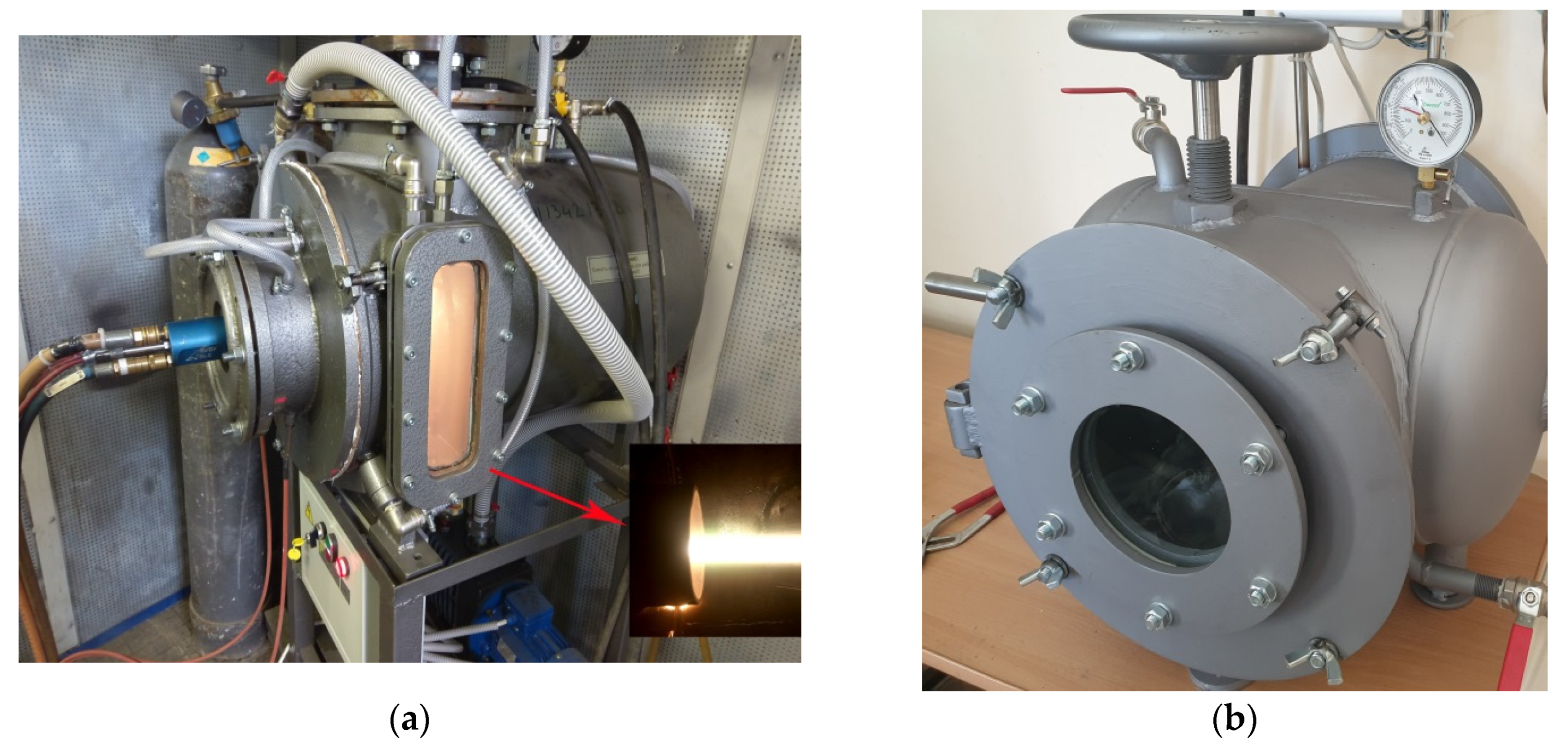
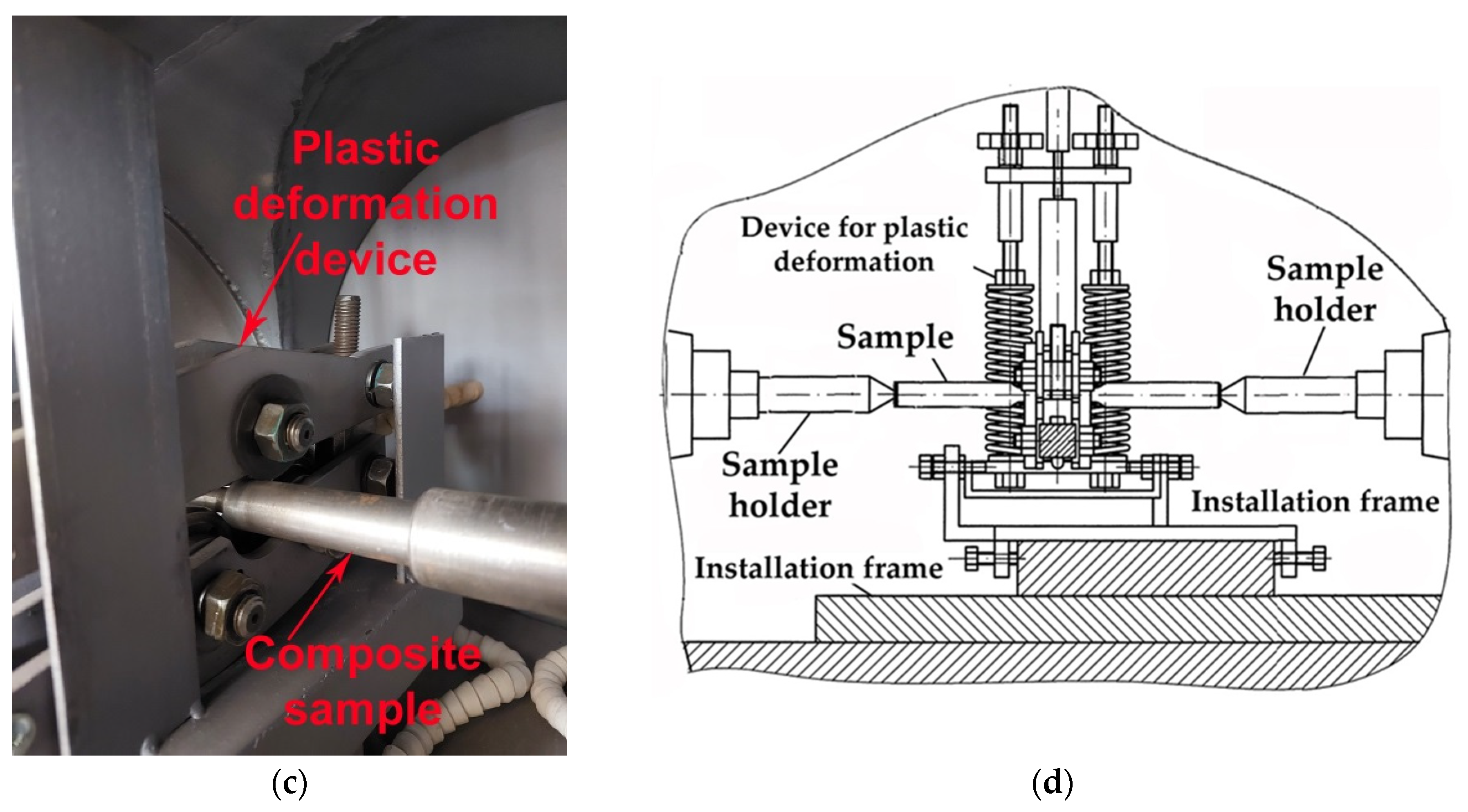
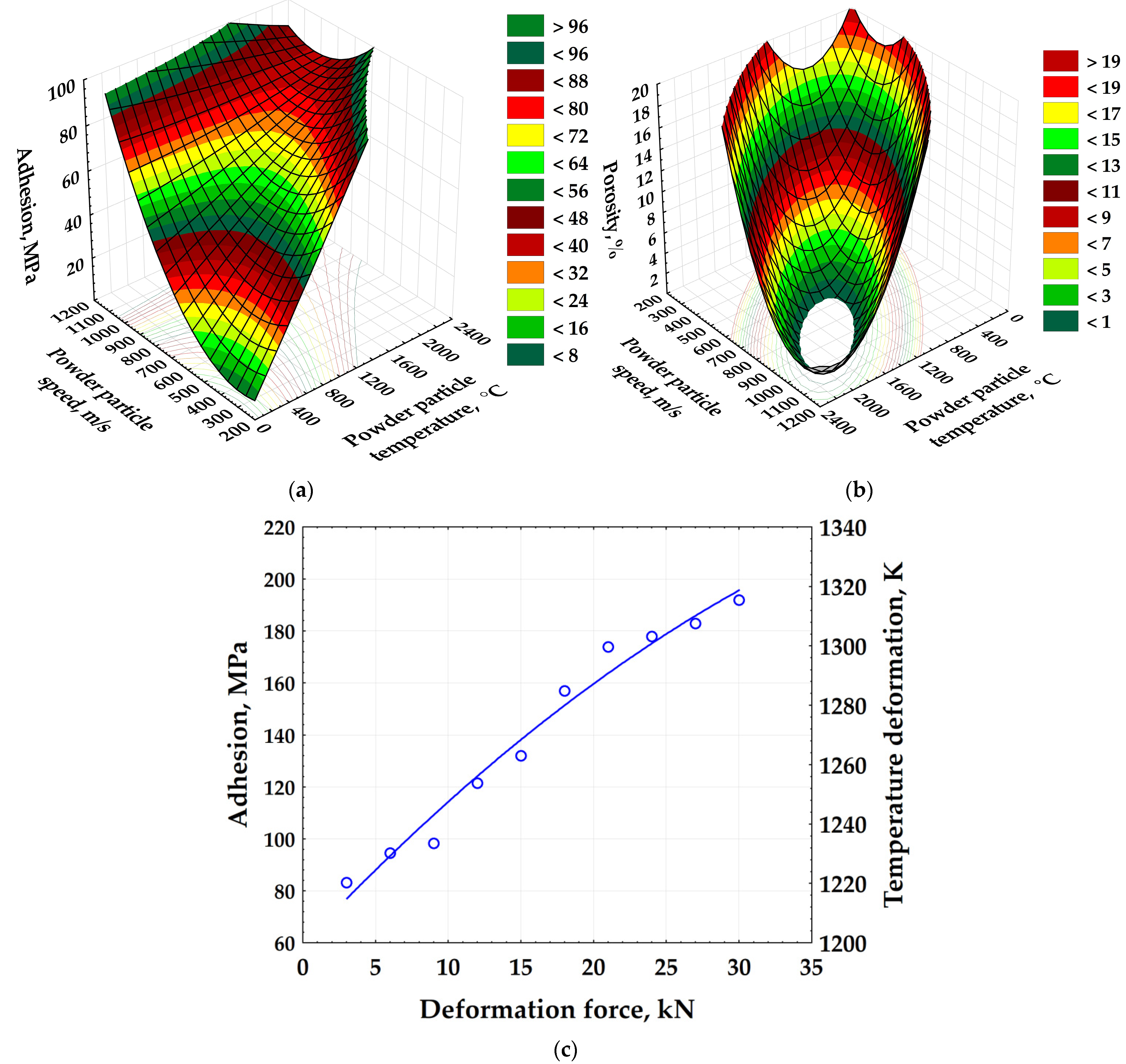
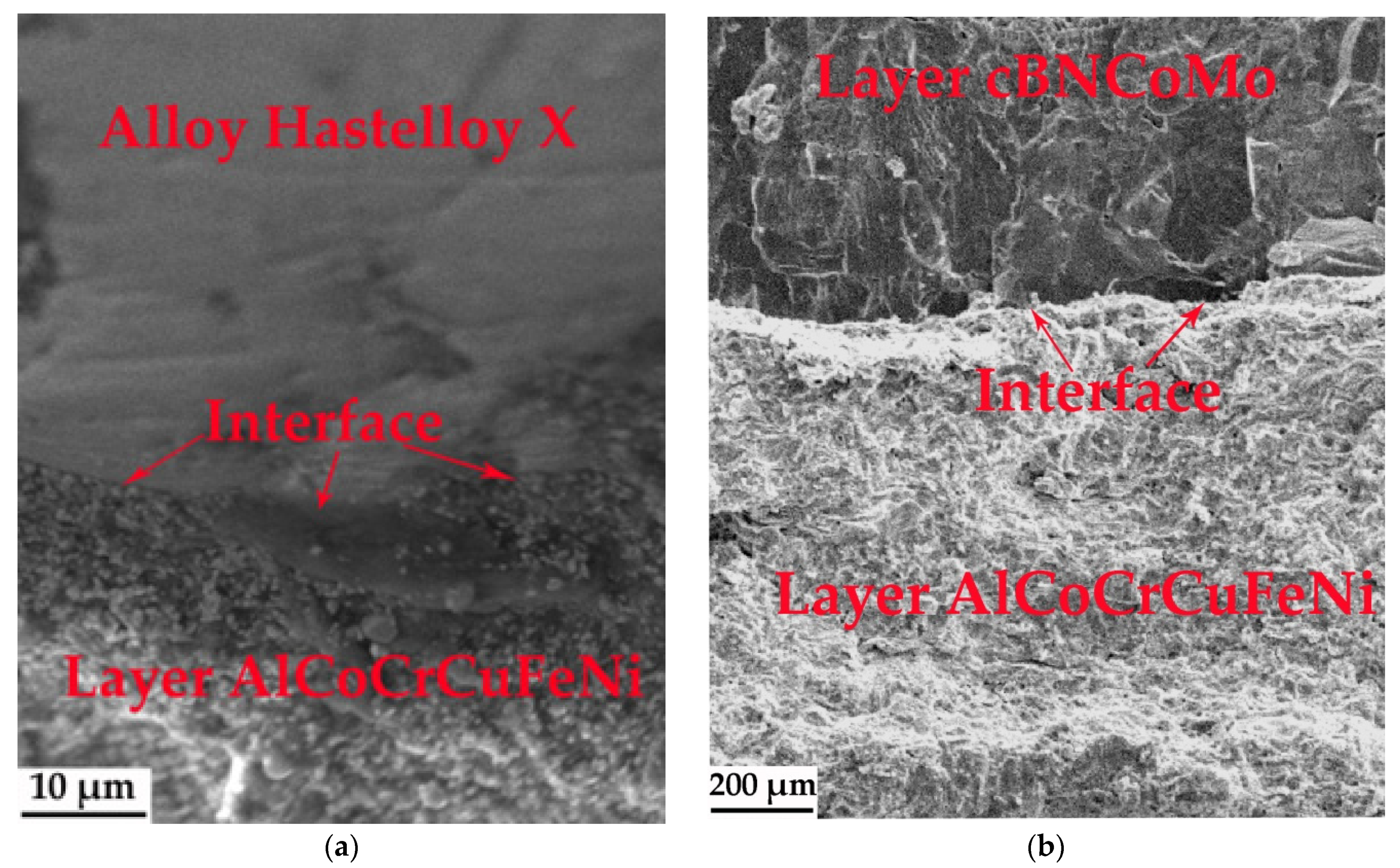
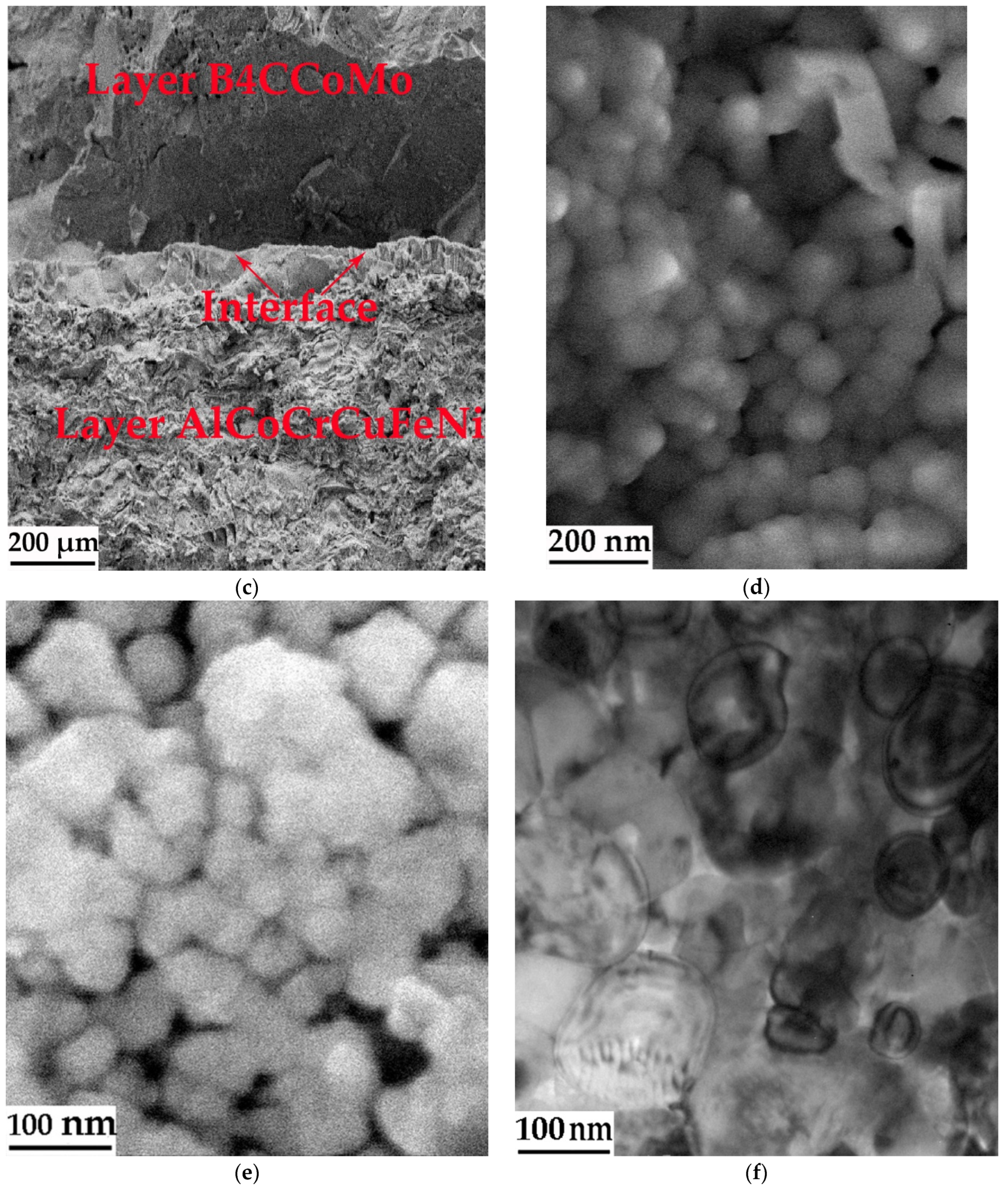
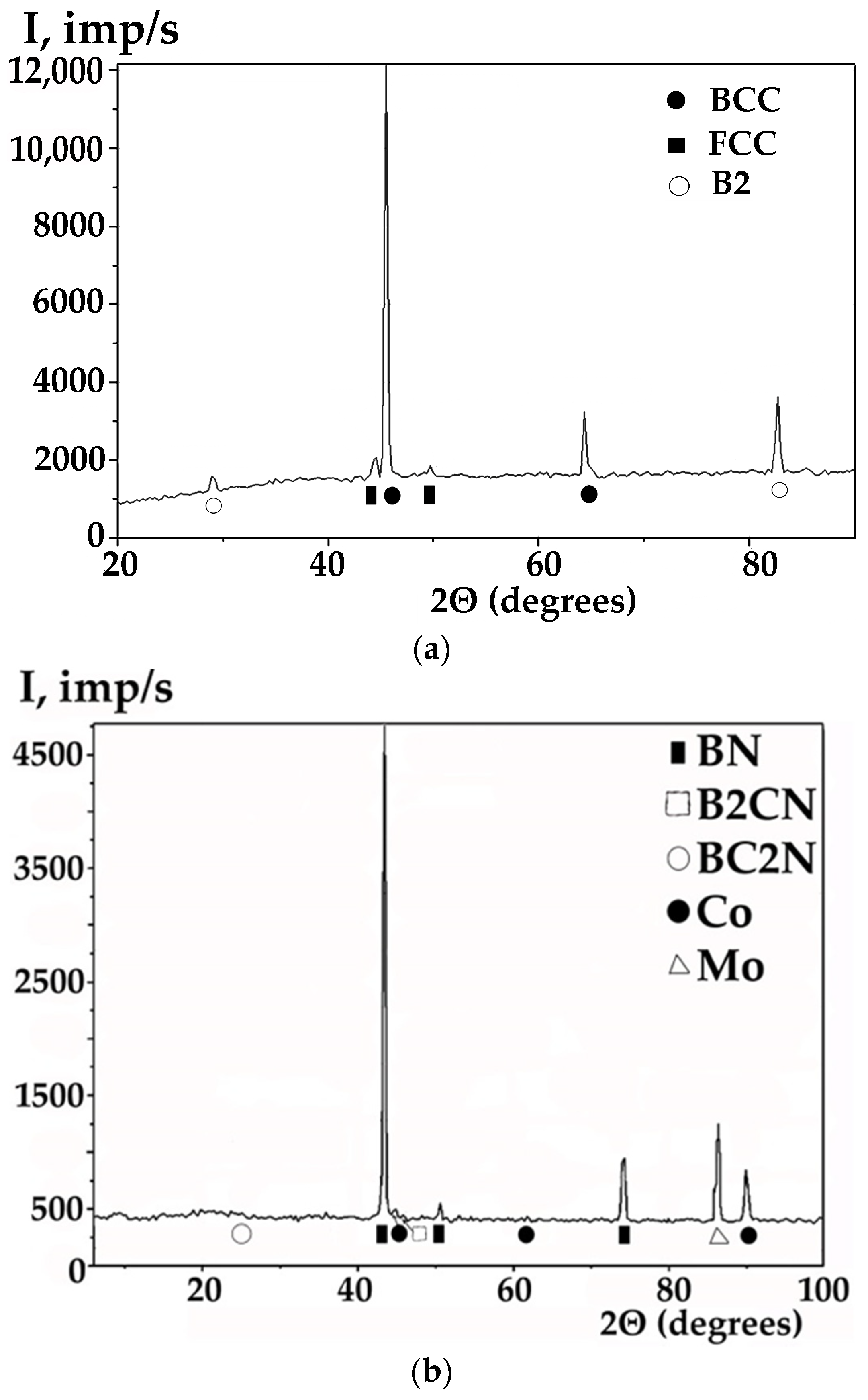
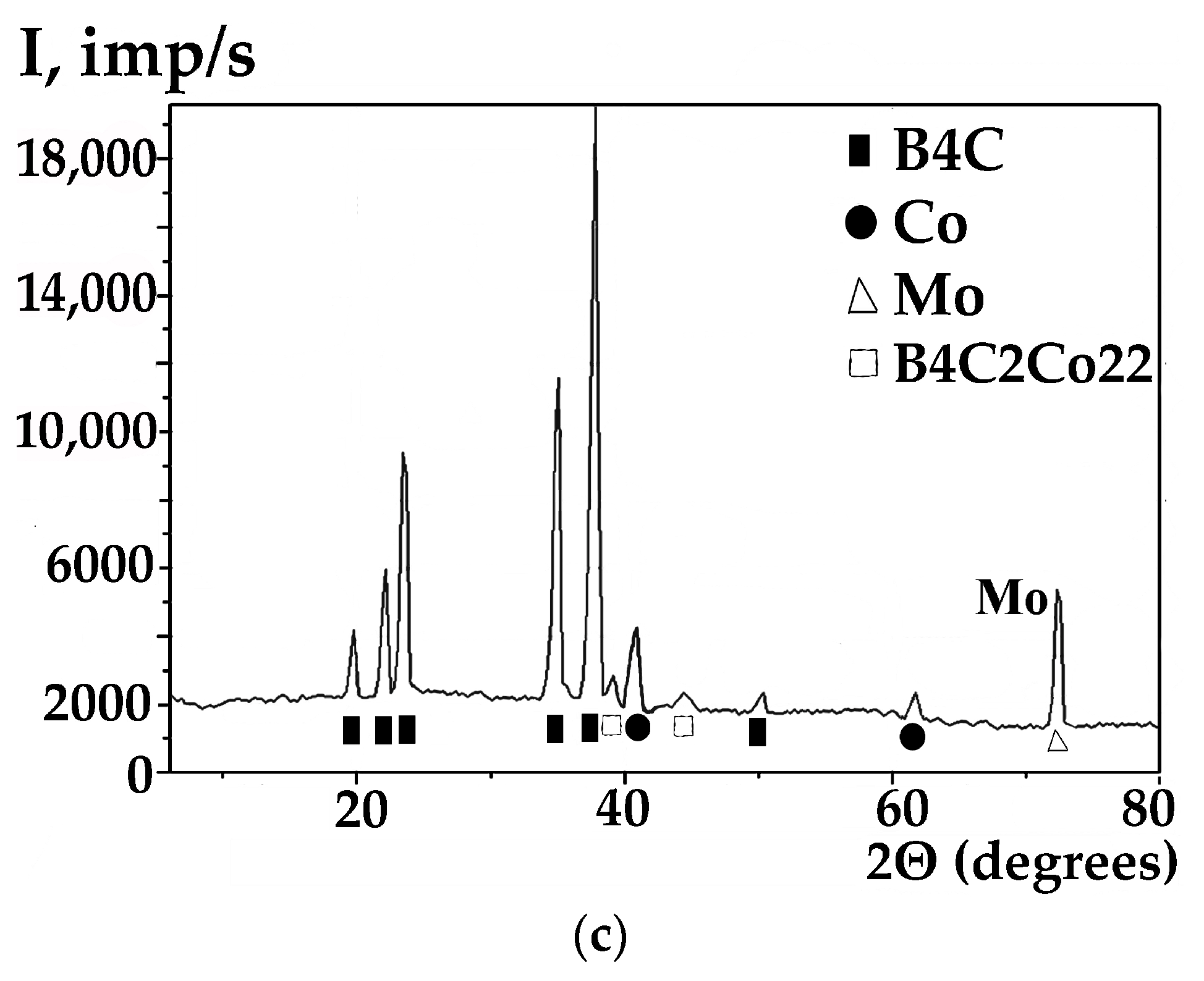
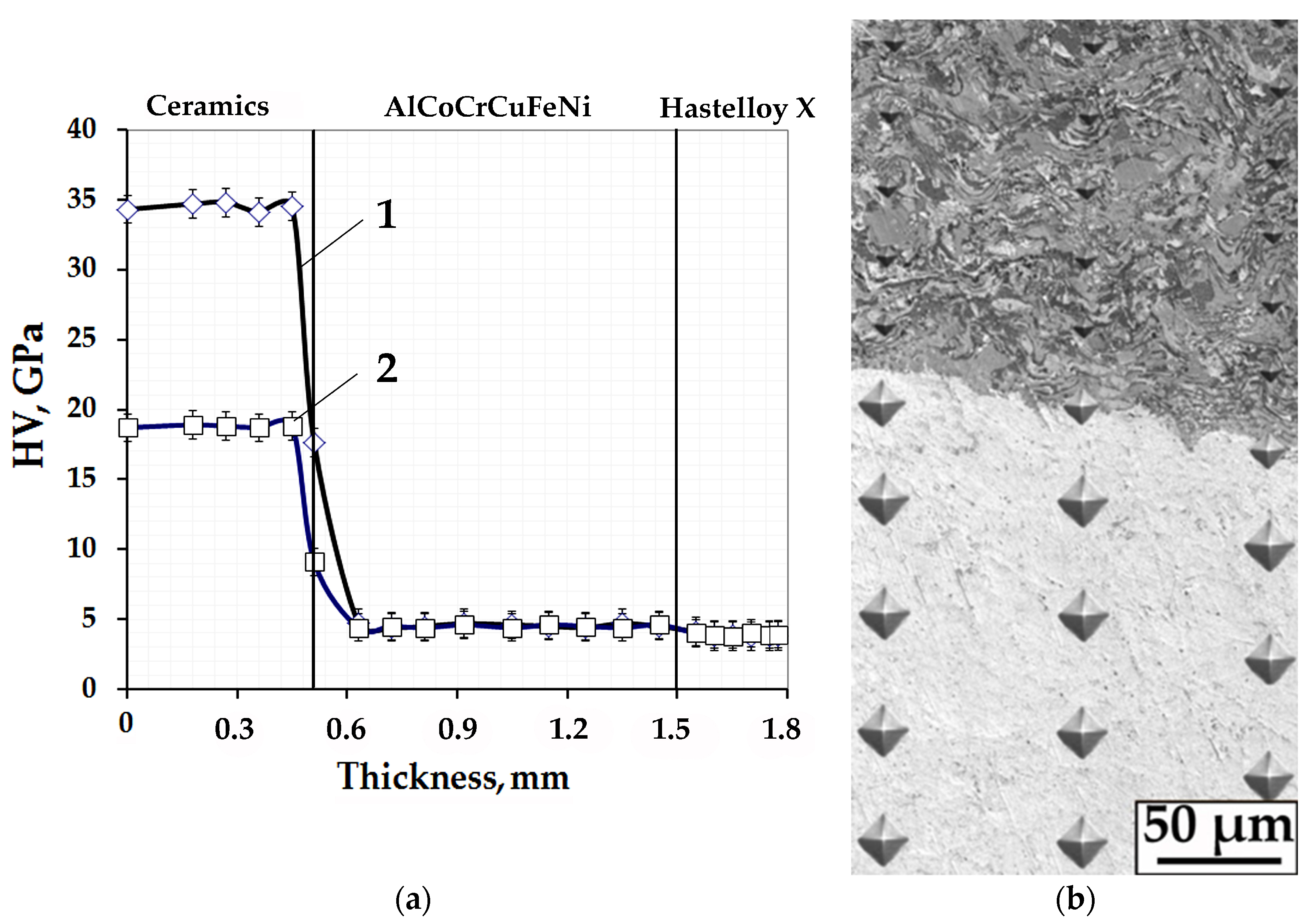
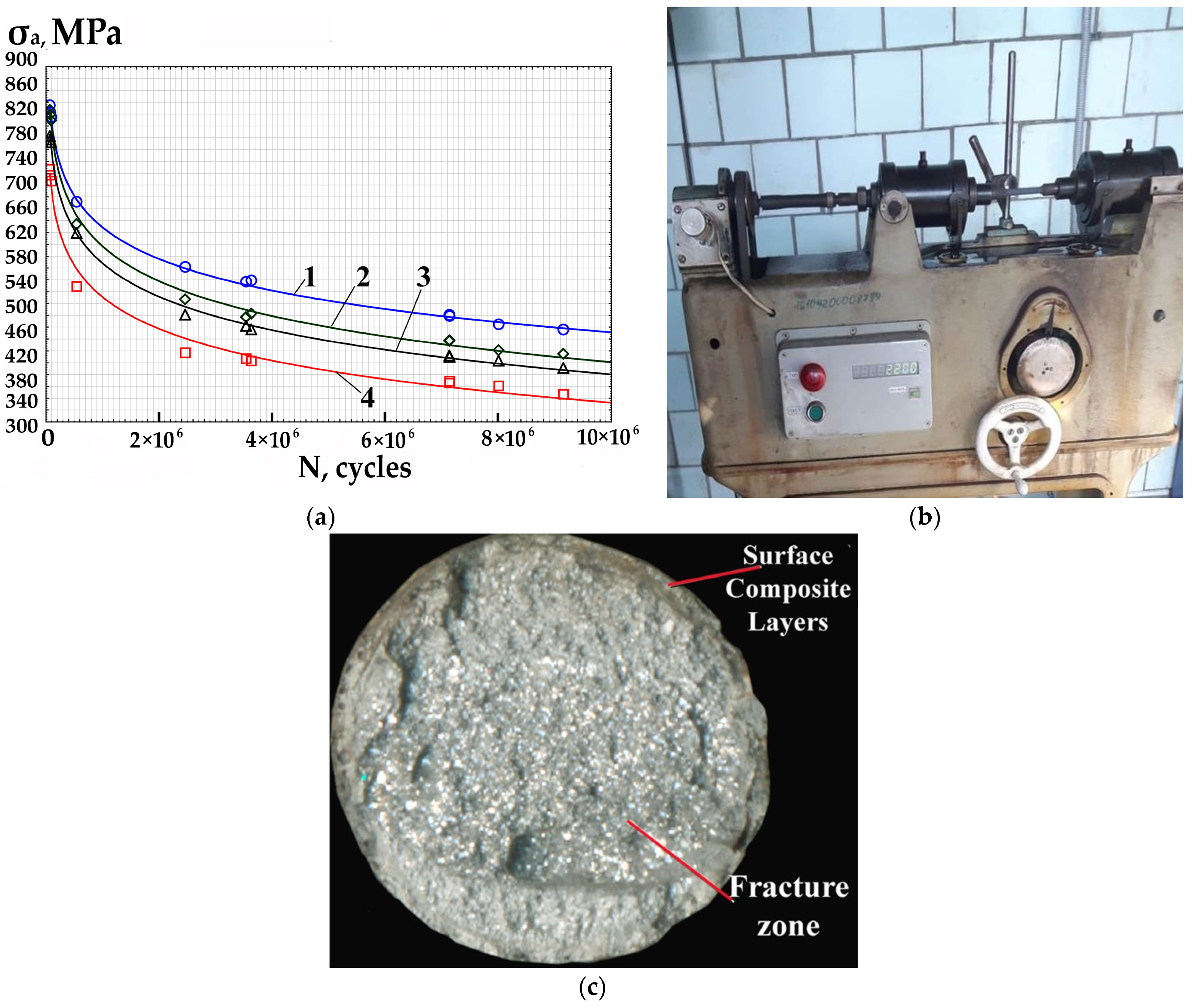

| Material | Ni | Mo | Cr | Fe | W | Co | Mn | C | P | S | Si | Al | Ti | B | Cu | cBN | B4C |
|---|---|---|---|---|---|---|---|---|---|---|---|---|---|---|---|---|---|
| Hastelloy X | 43.34 | 9.5 | 21.8 | 20.1 | 0.7 | 1.9 | 0.8 | 0.1 | 0.03 | 0.02 | 0.9 | 0.3 | 0.1 | 0.01 | 0.4 | - | - |
| AlCoCrCuFeNi | 16.7 | - | 16.7 | 16.7 | - | 16.7 | - | - | - | - | - | 16.6 | - | - | 16.6 | - | - |
| cBNCoMo | - | 5 | - | - | - | 10 | - | - | - | - | - | - | - | - | - | 85 | - |
| B4CCoMo | - | 5 | - | - | - | 10 | - | - | - | - | - | - | - | - | - | - | 85 |
| Phase | a, nm | Vat·103 | b, nm | c, nm | β, Degrees |
|---|---|---|---|---|---|
| cBNCoMo | |||||
| BN (cubic) | 0.3615 | 47.24 | 0.3615 | 0.3615 | 90.00 |
| B2CN (hexagonal) | 0.2574 | 25.49 | 0.2574 | 0.4442 | 90.00 |
| B2CN (orthorhombic) | 0.256 | 50.77 | 0.791 | 0.2507 | 90.00 |
| Co (hexagonal) | 0.2503 | 25.44 | 0.2503 | 0.406 | 90.00 |
| B4CCoMo | |||||
| B4 C (rhombohedral) | 0.5593 | 378.039 | 0.5593 | 1.2085 | 90.00 |
| B4 C2 Co22 (cubic) | 1.046 | 1144.445 | 1.046 | 1.046 | 90.00 |
| Co (hexagonal) | 0.2502 | 25.35 | 0.2502 | 0.405 | 90.00 |
| AlCoCrCuFeNi | |||||
| BCC (body-centered cubic lattice) | 0.2875 | 23.76 | 0.2875 | 0.2875 | 90.00 |
| FCC (face-centered cubic lattice) | 0.3608 | 46.97 | 0.3608 | 0.3608 | 90.00 |
| B2 (cubic) | 0.3207 | 32.98 | 0.3207 | 0.3207 | 90.00 |
| Functional Layers | Requirements | Efficiency |
|---|---|---|
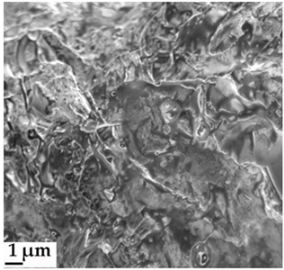 Layer of high-energy wear-resistant material cBNCoMo |
|
|
 Layer of high-entropy material AlCoCrCuFeNi |
|
|
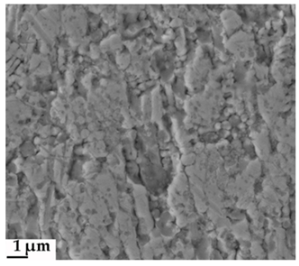 Base (Superalloy Hastelloy X(NiCrFeMo) |
|
|
Disclaimer/Publisher’s Note: The statements, opinions and data contained in all publications are solely those of the individual author(s) and contributor(s) and not of MDPI and/or the editor(s). MDPI and/or the editor(s) disclaim responsibility for any injury to people or property resulting from any ideas, methods, instructions or products referred to in the content. |
© 2023 by the authors. Licensee MDPI, Basel, Switzerland. This article is an open access article distributed under the terms and conditions of the Creative Commons Attribution (CC BY) license (https://creativecommons.org/licenses/by/4.0/).
Share and Cite
Rusinov, P.; Blednova, Z.; Rusinova, A.; Kurapov, G.; Semadeni, M. Development and Research of New Hybrid Composites in Order to Increase Reliability and Durability of Structural Elements. Metals 2023, 13, 1177. https://doi.org/10.3390/met13071177
Rusinov P, Blednova Z, Rusinova A, Kurapov G, Semadeni M. Development and Research of New Hybrid Composites in Order to Increase Reliability and Durability of Structural Elements. Metals. 2023; 13(7):1177. https://doi.org/10.3390/met13071177
Chicago/Turabian StyleRusinov, Peter, Zhesfina Blednova, Anastasia Rusinova, George Kurapov, and Maxim Semadeni. 2023. "Development and Research of New Hybrid Composites in Order to Increase Reliability and Durability of Structural Elements" Metals 13, no. 7: 1177. https://doi.org/10.3390/met13071177
APA StyleRusinov, P., Blednova, Z., Rusinova, A., Kurapov, G., & Semadeni, M. (2023). Development and Research of New Hybrid Composites in Order to Increase Reliability and Durability of Structural Elements. Metals, 13(7), 1177. https://doi.org/10.3390/met13071177






